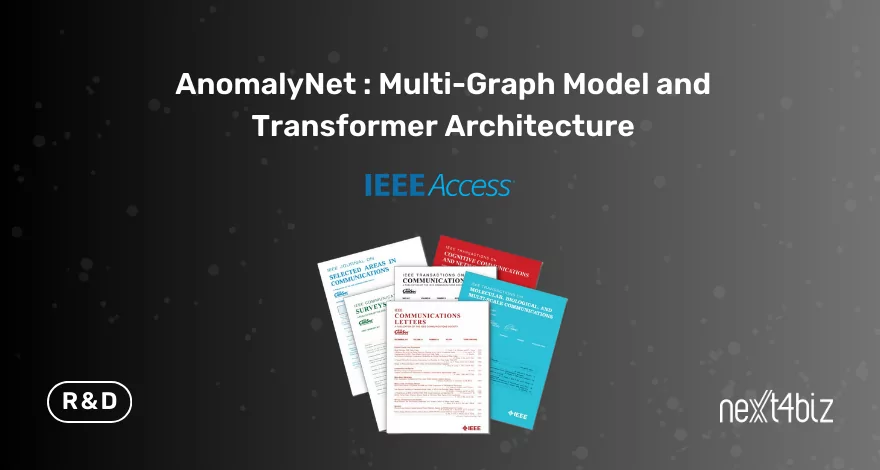
Business Context
The business environment has never been more dynamic. Technology, consumer habits, supply chain disruptions, demographic trends and shifts in work models continue to rapidly change the working environment of businesses, which while responding to these changes must continue delivering value: Stakeholder expectations must be fulfilled, regulatory constraints and environmental standards met, and business targets achieved.
To face off these challenges and survive, businesses need to be in a perpetual state of reinvention. The most ready-to-hand tool of change is the way in which business is executed, the tasks and practices employed to produce business goals, or more formally business processes.
In the past, when businesses could discover a successful formula for “how things are done” and stick to it, business processes were largely transparent to business thinking. Today, we understand business processes as constructs to be discovered, defined, measured, analyzed, improved, and optimized in a continuous pursuit of excellence. The discipline of BPM (Business Process Management) has arisen in response to this need.
As a discipline, BPM is applicable to all types and models of businesses, from logistics to finance, manufacturing to health and education, brick-and-mortar to online-only, SMEs to large corporations, and from private entities to public institutions and charities. The differentiation between organizations lies in the structure of their specific business processes. Effective BPM is about the ease and success of designing and executing business processes that accurately encapsulate the unique strengths of organizations.
The digitization of business processes and the velocity of change that BPM must address, makes the use of supporting software tools practically indispensable for effective BPM. The system of software and practices that support BPM within an organization is called a Business Process Management System (BPMS). A BPMS encompasses a range of tools and facilities:
- Business process design and modeling
- Process workflows and business rules
- Integration of domain-specific applications into process execution
- User interface construction and electronic forms
- Process testing and quality assurance
- Process deployment, automated execution and orchestration
- Process monitoring, measurement, performance reporting, and optimization
Business Process Models and Process Modeling Notations
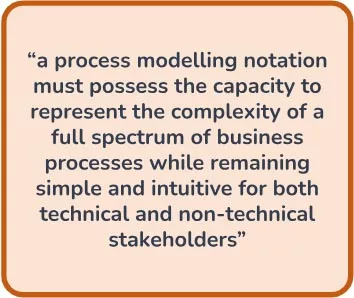 Process models are central to a BPMS. They represent a conceptualization of how business processes execute and makes it amenable to inspection, analysis and evaluation. Process models are above all, vehicles of communication among process stakeholders.
Process models are central to a BPMS. They represent a conceptualization of how business processes execute and makes it amenable to inspection, analysis and evaluation. Process models are above all, vehicles of communication among process stakeholders.
Process stakeholders encompass a wide array of individuals and organizations, including process owners, project managers, employees, analysts, auditors, regulatory agencies, investors, shareholders, customers, business partners, communities, and unions, among others. Stakeholder interest may range from understanding processes to active involvement in development, assessment, change, approval, implementation, application, management, or execution of processes. Regardless, process models must be mutually understandable by an audience with diverse interests and backgrounds.
Effective mutual understanding necessitates a shared vocabulary and universally accepted methods of expression, known as a notation. However, finding a suitable notation is a formidable task: a process modeling notation must possess the capacity to represent the complexity of a full spectrum of business processes while remaining simple and intuitive for both technical and non-technical stakeholders. Additionally, as BPM applications must translate process models into functional processes, the notation must maintain consistency and unambiguity.
Understanding BPMN 2.0
Various (often pictographic) notations have emerged and evolved over time to address these frequently conflicting demands with varying degrees of success. Among these, the BPMN has garnered widespread acceptance, particularly since the introduction of its latest version, 2.0. The acronym BPMN 2.0 stands for 2.0, business process model, and Notation.
BPMN 2.0 can represent complex business processes in a clear and standardized manner. It provides a structured way to model business processes using a set of universally understood symbols, effectively showcasing the flow of activities from start to end events.
BPMN 2.0 Offers Several Key Advantages
- Visualization of Business Processes: It simplifies the representation of intricate business processes by employing standardized symbols that illustrate the flow of activities from start to end events.
- Precise Documentation: BPMN ensures precise documenting of business processes, reducing the likelihood of misinterpretation.
- Process Analysis and Improvement: The notation supports in-depth analysis and identification of potential process enhancements without the risk of misunderstanding.
- Effective Communication: BPMN provides a common language for discussing and communicating business processes among stakeholders.
The expressiveness of BPMN 2.0 is such that it enables the creation of software applications capable of executing the process descriptions contained within BPMN models.
Managed by the not-for-profit organization, the Object Management Group Consortium, BPMN 2.0 has received ratification from the International Organization for Standardization (ISO). The latest iteration of the notation, OMG BPMN 2.0.1 (or equivalently ISO/IEC 19510:2013), represents a significant advancement over its predecessor, version 1.2. This upgrade encompasses the introduction of new notations and diagram styles, alongside technological advancements that enhance data interchange and refine process execution semantics.
Process Modeling Notations
The development of the Business Process Model and Notation (BPMN) 2.0 by the Object Management Group (OMG) built on the experiences of many preceding notations. The following table provides a side-by-side feature comparison of some of these. It’s evident that BPMN not only addresses the limitations of earlier notations but also introduces advanced features, creating a versatile and powerful language for representing, analyzing, and executing business processes.
| Purpose | Focus | Approach | Scope | Purpose-specific | Expressiveness | Complexity | Executable | Standardized | Tool support | Popularity | |
| Flowcharts | Model the flow of control in a process | In-process control flow | Graphical notation | Any type of process | No | Low | Low | No | No | High | High |
| DFD | Model the flow of data in a system | In-system data flow | Graphical notation | Any type of system | No | Low | Low | No | No | Med | Med |
| IDEF3 | Model the flow of activities in a system | In-system activity flow | Graphical notation | Any type of process | No | Med | Med | No | Yes | Low | Med |
| EPC | Model business processes | In-process activity flow | Graphical notation | Any type of process | Yes | Med | Med | No | No | Med | Med |
The wide acceptance of BPMN 2.0 as a shared language promotes process knowledge reuse across contexts, organizations, and personnel transfers. It aids in documenting best practices and supports organizational transactions like mergers and alliances.
BPMN’s comprehensibility fosters buy-in and organizational acceptance of process improvement. Executable processes and monitored outcomes increase stakeholder confidence in ambitious goals.
What is the Difference Between BPMN 1.0 and BPMN 2.0
For versions 1.0, 1.1 and 1.2 BPMN stood for Business Process Modeling Notation. During the progression of 1.x minor releases the number of standardized BPMN Elements steadily increased.
What BPMN stands for changed from 1.x to 2.0, becoming Business Process Model and Notation reflecting enhanced specifications to aid business analysts and business infrastructure developers. The number of BPMN 2.0 symbols increased significantly again compared to version 1.2. On the technical side, process execution semantics were introduced with version 2.0, facilitating simulation, animation and execution of business process models by BPMN tools.
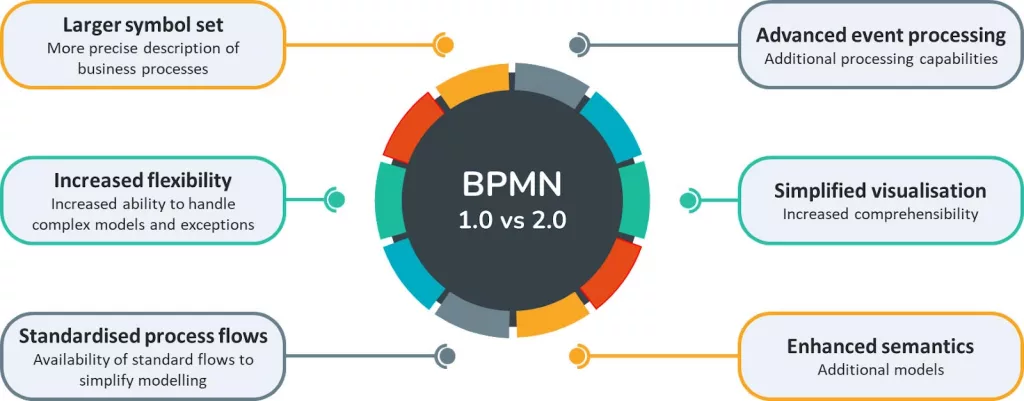
What are the Advantages of BPMN 2.0
Selecting a Business Process Management Suite (BPMS) that supports BPMN 2.0 offers numerous advantages to organizations, which can be categorized into four key areas:
Facilitating Internal and External Communication
BPMN 2.0 is used for communication in and between organizations. Its notation is highly accessible to stakeholders from diverse backgrounds, and its widespread adoption means that tools and training are readily available.
Enhanced process understanding: BPMN 2.0 provides easily comprehensible process knowledge, leading to improved stakeholder understanding, transparency, and trust.
Integration into inter-organizational processes: The ubiquity of BPMN 2.0 and the availability of supporting tools make it easier to integrate into inter-organizational processes. This fosters collaboration and simplifies cross-boundary operations.
Simplified auditing: The popularity of BPMN 2.0 as a universal language simplifies both internal and external auditing processes, enhancing trust in the organization and simplifying compliance.
Providing Accessible and Concise Documentation for Business Processes
Historically, process documentation in BPM has often lagged behind process changes and inaccurately represented current business processes. BPMN 2.0 process models, when implemented within a suitable BPMS capable of generating executable processes, ensure that process documentation accurately reflects the current state.
- Streamlined onboarding: Access to standardized and up-to-date process documentation simplifies the onboarding process by reducing the learning curve for new hires.
- Real-time awareness: Up-to-date and accessible documentation ensures that all stakeholders can immediately be informed of process changes.
Enabling Process Improvement and Optimization
BPMN 2.0’s standardized notation makes it easy to articulate, visualize, and review process improvement proposals and designs. This reduces communication gaps and shortens the process improvement cycle.
- Strategic and operational modeling: With BPMN 2.0, business processes can be modeled at both strategic and operational levels, allowing for varying levels of detail as needed. Sub-process Activities can be decomposed into sub-models, enabling top-down business process visualization for impact analysis.
- Facilitating improvement cycles: BPMN 2.0, when integrated into a suitable BPMS, enables efficient model-test-execute-monitor cycles, accelerating process improvement and achieving optimized solutions. The low cost of improvement encourages frequent cycles of enhancement.
Increasing Productivity and Reducing Costs
The ease of mastering BPMN 2.0 notation accelerates process design and redesign and enhances communication among stakeholders. When combined with round-trip model-test-execute-monitor cycles provided by a suitable BPMS, this significantly reduces resource and time costs associated with process improvement.
Eliminating Coding: BPM solutions capable of generating process executables without coding save substantial time and human resources.
Promoting Design Reusability: BPMN 2.0 facilitates process design reusability, eliminating the effort and risks associated with design duplication and enhancing overall quality.
Enhancing Process Performance Monitoring: BPMN 2.0 allows direct association of process performance monitoring with model elements, improving transparency and enabling rapid identification of inefficiencies and bottlenecks.
Basic Elements of BPMN 2.0 Notation
The BPMN 2.0 standard has a large number of symbols with which processes can be fully expressed. Importantly, only a small subset of these need to be learnt to understand and articulate process models. Here are the most fundamental BPMN 2.0 symbols:
Events represent a happening that changes a system state. The symbol for an event is an unfilled circle.
A Start Event is a kind of event that has a trigger defining the cause for the event and initiating process flow. It is differentiated by having a single line thick border. The Start Event of a HR “resume screening process” might be “job application received.”
An End Event is a kind of event that denotes a result and termination of a process flow. It is differentiated by having a filled ring border. The End Event of a HR “resume screening process” might be “resume disqualified.”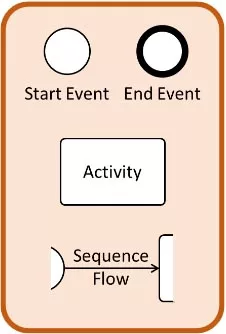
An Activity is a unit of work performed as a step in a business process. Its symbolic representation on BPMN diagrams is as a rectangle with rounded corners. An activity in a HR “resume screening process” might be “check references”. Activities may represent atomic tasks or sub-processes that have their own process model and may potentially be reused in other process models.
A Sequence Flow denotes the order of activities performed within a process. It is represented as an arc terminating in an arrow. Sequence Flows connect Events to Activities, Activities to Events and Events to Events. In an HR “resume screening process” the first Activity following a “job application received” Start Event may be “prescreening”. This relationship would be represented by a Sequence Flow beginning at the “job application received” Event and terminating with an arrowhead at the “prescreening” Activity.
The BPMN 2.0 standard defines more diagram elements and many variant symbols for these elements but this basic set is expressive enough to depict most processes.
Augmenting BPMN 2.0 with BPMS
While BPMN 2.0 offers a comprehensive notation for describing process logic, it may sometimes fall short in providing all the necessary elements to generate executable processes. This is where the Business Process Management System (BPMS), of which the BPMN modeling facility is part, comes into play. The BPMS can enrich BPMN models with additional design elements. Here are some key aspects:
Organizational structures: The BPMS can support organizational structures, including departments or workgroups, and their hierarchical relationships. These structures can be referenced by BPMN Activities. Group members within an organization can share the same roles, allowing for automated or manual task assignment, simplifying workload management. Organizational relationships can also help determine workflow escalation based on these relationships, streamlining process models by eliminating unnecessary complexity.
Data structures: BPMS can define simple or complex data structures for use in both user and system interfaces. Additionally, a predefined set of process management data elements may be provided by the BPMS, ensuring consistency, standardization and redundancy elimination.
Data pages: User interfaces for Activity processing can be customized to include both custom and predefined data elements. Complementary pages, such as notes, processing history, processing details, notifications, and related processes, may be available or auto-generated for use in conjunction with a BPMN model. BPMS may also offer a notification system and a template infrastructure for in-process messaging among stakeholders.
Business rules: In many instances, Activity execution and process flow are subject to complex business rules. These rules play a crucial role in determining processing procedures, assigning responsibilities, and sequencing Activities. The execution of business rules is a vital component of process execution within the BPMS environment. The way in which business rules are supported is also important. Most BPM solutions allow custom software code to be used to implement business rules. However, coding is a resource and risk intensive process. A low, or preferably no code facility to design business rules is generally preferable.
Modeling Business Processes with BPMN 2.0
Having decided on the BPMN 2.0 notation, the next step is to put the notation to use in modeling business processes. But before actual modeling can begin, an in-depth investigative analysis of the process to be modeled must be carried out. However good the notation used, without thorough understanding of the business process, the produced model will not serve purpose.
Analysis
Business process analysis involves gathering and comprehending information about process boundaries and structure. The following are the key facets of business process modeling. The contents and emphasis of a particular analysis performed may vary based on specific needs, such as documenting existing processes or implementing new ones.
Identification: Determine the purpose of the process, its inputs, outputs, resource requirements, and initiation and termination states of the system.
Improvement: Identify areas for process improvement, define success metrics, and pinpoint weaknesses or bottlenecks.
Governance: Understand which bylaws, business policies, and regulations govern the process.
Processing: Map the main processing steps, including triggers, precedence relationships, and decision outcomes. Map exceptional scenarios, their triggers and outcomes.
Data: Analyze data consumption and production in each step, as well as the user or system interfaces associated with these data.
Organization: Identify the individuals, departments, or groups involved in executing process steps.
Flow: Define decision points, business rules, and their impact on process flow and the sequencing of process steps.
Control: Establish measurements, performance indicators, and conditions for monitoring. Determine KPI contributions of the process.
Risk management: Assess process-related risks and strategies for managing them.
Review and approval: Submit process analysis to stakeholder review and organizational approval before proceeding with the formal modeling process.
Modeling
Once a thorough analysis of the process is complete, the modeling phase can commence. Modeling business processes with BPMN 2.0 is akin to an art form—a skill that matures with experience and practice. While the full depth of this skill can’t be fully explored within the scope of this article, the following tips and suggestions are designed to set you on the right path:
Process Identification: Guided by the results of your analysis and project priorities, identify the business process to model. Ensure that the process boundaries are well-defined, with a focus on what to exclude rather than what to include. Provide a concise, descriptive name, and include an adequate description to convey the process’s essence.
Collaboration: Assemble a diverse team of stakeholders to actively participate in the modeling process. Diverse perspectives and expertise lead to more comprehensive and effective process models.
Standards: Establish clear diagramming, documentation, and naming standards in advance. Adhering to these standards is vital for maintaining consistency and ensuring clarity in your BPMN models. Consistency fosters better communication and understanding.
Primary Scenario: Begin by outlining the primary flow of the process, detailing the sequence of Activities. This primary scenario represents the expected or “happy path” of the process.
Alternative Scenarios: Identify and document alternative scenarios that represent exceptional cases, deviations, or failures within the process. These scenarios should have been pinpointed during the analysis phase.
Layout: Pay attention to the layout of the BPMN diagram. Arrange Activities for the primary scenario left to right, following a near-linear progression from Start Events to End Events, connecting them with Sequence Flows. For alternative scenarios, branch out from the primary scenario layout. A well-organized layout enhances the visual clarity of your model.
Decomposition: When appropriate, incorporate reusable sub-process Activities from your library. Alternatively, identify Activities that can be assigned to a sub-process to enhance model clarity or contribute to your library of reusable sub-processes. Reusing sub-processes reduces redundancy and simplifies model maintenance.
Refinement: Begin with a basic model and gather feedback from stakeholders. Perform refinement iterations as needed to strike the right balance between model size and detail. Continuous refinement ensures that your BPMN model accurately reflects the evolving business process.
Verification and validation: Verify the process model with stakeholders against process analysis results. Validate the model through simulation and testing. Involve end-users in the testing process to identify usability and practicality issues.
How to Choose BPMN 2.0 Tool?
Choosing BPMN 2.0 software is not simple. Many alternatives exist to suit differing requirements. Most provide a modern graphical design interface for process modeling with a tool palette from which model elements may be chosen, and drag-drop style manipulation. Other features vary. In choosing BPMN 2.0 software, here are the factors to consider:

User environment
Collaborative diagramming:
Except for localized very small teams, collaborative diagramming is a must. It allows simultaneous contributions by stakeholders to a model and, by eliminating the pain of consolidating changes from multiple sources, is a great productivity booster.
Web access: The BPMN 2.0 modeling environment should be accessible from all devices with web access and not necessitate locally installed client software to maintain.
Ease of use: The BPMN 2.0 tool and associated tools should have a uniform and simple user interface.
Business Perspective
Service architecture: BPMN 2.0 tools should not be an additional burden for the IT department to manage. Tool support should be provided as a service accessible from everywhere (with the correct credentials), to support distributed working.
Ecosystem: The BPMN 2.0 tool should be supported by an established organization and used by a wide community of assorted organizations to provide business continuity confidence.
Budget: Perhaps the most important (though non-technical) aspect of tool selection is overall cost and value for money. In addition a subscription style pricing structure is beneficial in responding to managing contraction and expansion cycles.
Life-Cycle Support
Business Process Management System (BPMS): For medium to large organizations in a dynamic business environment, manually implementing process models is infeasible. BPMN 2.0 tools should be part of a wider BPMS that facilitates rapid round-trip design, testing, deployment, monitoring process life-cycles.
Integration: In a typical environment many processes will flow through multiple systems, internal and/or external to the organization. To apply BPMN models in real-world scenarios, BPMS support for an in-built integration model making system integration straightforward, is essential.
Monitoring: BPMS should enable process performance to be monitored and analyzed so action can be taken to improve processes that begin to underperform immediately.
Turnaround: When the decision for process improvement is made, a sufficient copy of the execution environment should be made available for process improvement by BPMS on-the-fly, and similarly the re-modelled/improved and tested processes should be releasable immediately. In addition to deployment, the design of business rules supporting the BPMN models should not necessitate coding. Coding is inherently risky and resource consuming. A high turnaround time is the measure of your organizational agility in responding to change.
BPMN 2.0 Examples and Real-Life Applications
next4biz is a company at the forefront of BPM innovation and has extensive experience across industries, from Banking to Energy, Manufacturing to Retail. next4biz has partnered with leading companies to provide them with the tools and infrastructure they need to model, manage, and optimize their business processes, demonstrating time and again the strength of BPMN and next4biz’s overall BPM solution.
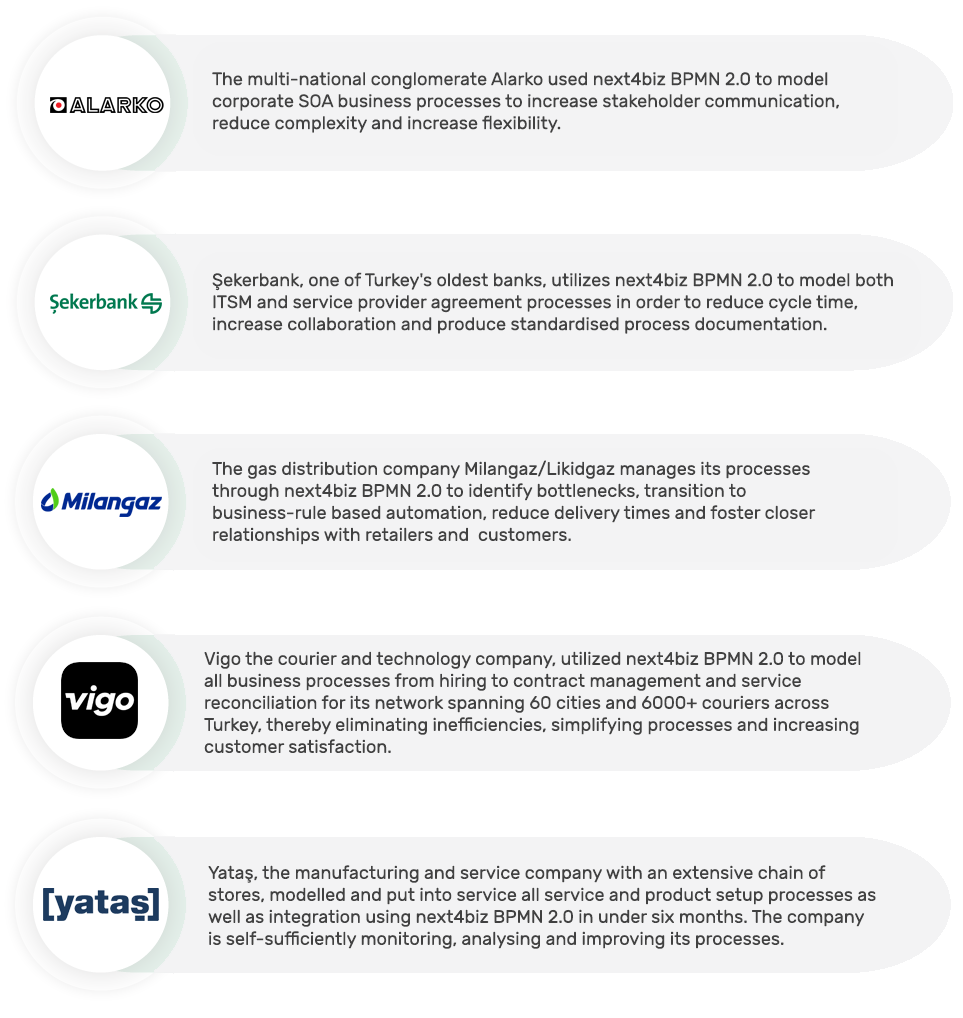
Summary
In a world of change, businesses must continuously respond by improving their business processes to meet new challenges. Business Process Management Systems (BPMS) facilitate round-trip design, testing, deployment, monitoring process life-cycle management.
To model business processes it is necessary for all stakeholders to share a common notation in which these models are expressed. BPMN 2.0 is a notation easily understood by stakeholders from all backgrounds, yet is concise and precise, and can be used to generate executable processes by the BPMS.
BPMN 2.0 is an internationally recognized standard managed by the Object Management Group Consortium that builds on the strengths of many notations preceding it. Version 2.0 is a significant improvement over BPMN 1.0 and intermediary 1.x versions.
The most important aspect of utilizing BPMN 2.0, is as a means of internal and external communication. As a standard notation, it allows all process stakeholders to utilize it as a source of accessible documentation too.
With such a versatile notation and BPMS support, not only is the process of process improvement streamlined, but the actual business processes implemented can be monitored for improvement opportunities and continually optimized to ensure lowest cost – highest benefit operations.
BPMN 2.0 has a large number of notation elements. However a small number of them can be used to quickly gain expressive power. The Start/End Events, Activities and Sequence Flow constitute the basic set of symbols.
BPMN 2.0 does not cover all the elements necessary to generate executable processes. Organizational structures, data structures, data pages (for user interfaces) and business rules are elements that a capable BPMS supplies to complete the description of process model in sufficient detail to generate executable processes. It is important that implementing these elements, particularly business rules, need not necessitate coding. Coding is a high-risk resource intensive activity that can hinder BPM agility.
Even with the expressiveness of BPMN 2.0 and a capable BPMS supporting it, process modeling remains an art that needs experience to master. All modeling should be preceded by an effective analysis stage. The quality and utility of a process model is dependent on having a full complement of process knowledge available.
Choosing a BPMN 2.0 tool is not a trivial exercise. Accessibility and ease of use are important, but collaborative modeling is paramount in achieving modeling efficiency and stakeholder participation. From the business perspective, the availability of support and a thriving user community is critical, as is of course budgetary considerations. A service subscription type scheme is very advantageous in managing business growth and contraction cycles and in not increasing IT workloads. Except for very small businesses, independent BPMN tools are not usually a good idea. They should be part of a wider BPMS that facilitates rapid round-trip design, testing, deployment, monitoring process life-cycles. Consideration should also be made of the ease with which other systems can be integrated with the BPMS.
next4biz is at the forefront of BPM innovation with extensive experience spanning industries. The purpose of next4biz BPM is to enable companies to model, manage, and optimize their business processes utilizing only in-house resources.

